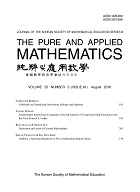 ISSN : 1226-0657
ISSN : 1226-0657
권호 목록
- 2024 (31권)
- 2023 (30권)
- 2022 (29권)
- 2021 (28권)
- 2020 (27권)
- 2019 (26권)
- 2018 (25권)
- 2017 (24권)
- 2016 (23권)
- 2015 (22권)
- 2014 (21권)
- 2013 (20권)
- 2012 (19권)
- 2011 (18권)
- 2010 (17권)
- 2009 (16권)
- 2008 (15권)
- 2007 (14권)
- 2006 (13권)
- 2005 (12권)
- 2004 (11권)
- 2003 (10권)
- 2002 (9권)
- 2001 (8권)
- 2000 (7권)
- 1999 (6권)
- 1998 (5권)
- 1997 (4권)
- 1996 (3권)
- 1995 (2권)
- 1994 (1권)
11권 2호
초록
Abstract
A computational algorithm is developed for fitting given data in the plane or in 3-space by implicitly defined quadrics. Implicity implies that the type of the quadric is part of the model and need not be known in advance. Starting with some estimate for the coefficients of the quadric the method will alternatively determine the shortest distances from the given points onto the quadric and adapt the coefficients such as to reduce the sum of those squared distances. Numerical examples are given.
초록
Abstract
Let T be an integral domain, M a nonzero maximal ideal of T, K = T/M, <TEX>$\psi$</TEX>: T \longrightarrow K the canonical map, D a proper subring of K, and R = <TEX>$\psi^{-1}$</TEX>(D) the pullback domain. Assume that for each <TEX>$x \; \in T$</TEX>, there is a <TEX>$u \; \in T$</TEX> such that u is a unit in T and <TEX>$ux \; \in R$</TEX>, . In this paper, we show that R is a weakly Krull domain (resp., GWFD, AWFD, WFD) if and only if htM = 1, D is a field, and T is a weakly Krull domain (resp., GWFD, AWFD, WFD).
초록
Abstract
<TEX>$H_v$</TEX>-rings first were introduced by Vougiouklis in 1990. The largest class of algebraic systems satisfying ring-like axioms is the <TEX>$H_v$</TEX>-ring. Let R be an <TEX>$H_v$</TEX>-ring and <TEX>${\gamma}_R$</TEX> the smallest equivalence relation on R such that the quotient <TEX>$R/{\gamma}_R$</TEX>, the set of all equivalence classes, is a ring. In this case <TEX>$R/{\gamma}_R$</TEX> is called the fundamental ring. In this short communication, we study the fundamental rings with respect to the product of two fuzzy subsets.
초록
Abstract
In this paper we derive a decomposition of the solution of Fredholm equations of the second kind in terms of reproducing kernels in the space <TEX>${W_2}^2$</TEX>(<TEX>$\Omega$</TEX>)
초록
Abstract
Let {<<TEX>$\mathds{X}_t$</TEX>} be an m-dimensional linear process of the form <TEX>$\mathbb{X}_t\;=\sumA,\mathbb{Z}_{t-j}$</TEX> where {<TEX>$\mathbb{Z}_t$</TEX>} is a sequence of stationary m-dimensional negatively associated random vectors with <TEX>$\mathbb{EZ}_t$</TEX> = <TEX>$\mathbb{O}$</TEX> and <TEX>$\mathbb{E}\parallel\mathbb{Z}_t\parallel^2$</TEX> < <TEX>$\infty$</TEX>. In this paper we prove the central limit theorems for multivariate linear processes generated by negatively associated random vectors.
초록
Abstract
We show that the Choquet boundary of the tensor product of two real function algebras is the product of their Choquet boundaries.
초록
Abstract
In this paper, we introduce new monotone concepts for set-valued mappings, called generalized C(x)-L-pseudomonotonicity and weakly C(x)-L-pseudomonotonicity. And we obtain generalized Minty-type lemma and the existence of solutions to vector variational inequality problems for weakly C(x)-L-pseudomonotone set-valued mappings, which generalizes and extends some results of Konnov & Yao [11], Yu & Yao [20], and others Chen & Yang [6], Lai & Yao [12], Lee, Kim, Lee & Cho [16] and Lin, Yang & Yao [18].
초록
Abstract
Given vectors x and y in a separable Hilbert space <TEX>$\cal H$</TEX>, an interpolating operator is a bounded operator A such that Ax = y. In this article, we investigate Hilbert-Schmidt interpolation problems for vectors in a tridiagonal algebra. We show the following: Let <TEX>$\cal L$</TEX> be a subspace lattice acting on a separable complex Hilbert space <TEX>$\cal H$</TEX> and let x = (<TEX>$x_{i}$</TEX>) and y = (<TEX>$y_{i}$</TEX>) be vectors in <TEX>$\cal H$</TEX>. Then the following are equivalent; (1) There exists a Hilbert-Schmidt operator A = (<TEX>$a_{ij}$</TEX> in Alg<TEX>$\cal L$</TEX> such that Ax = y. (2) There is a bounded sequence {<TEX>$a_n$</TEX> in C such that <TEX>${\sum^{\infty}}_{n=1}\mid\alpha_n\mid^2 < \infty$</TEX> and <TEX>$y_1 = \alpha_1x_1 + \alpha_2x_2$</TEX> ... <TEX>$y_{2k} =\alpha_{4k-1}x_{2k}$</TEX> <TEX>$y_{2k=1} = \alpha_{4kx2k} + \alpha_{4k+1}x_{2k+1} + \alpha_{4k+1}x_{2k+2}$</TEX> for K <TEX>$\epsilon$</TEX> N.
